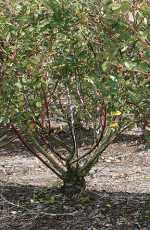
Pruning is widely recognized as an important cultural practice in the production of perennial fruit crops including blueberry. Benefits attributed to pruning blueberries include: 1) increased plant vigor and growth of new fruiting wood, 2) reduction in the incidence of certain diseases and improved pest management, 3) prevention of over-fruiting thereby enhancing berry size, quality, and earliness, 4) improved sunlight penetration into canopies for better flower bud set, and 5) desirable plant size and shape that facilitates cultural practices such as berry harvest.
General recommendations for pruning blueberries in traditional northern production areas include cane renewal pruning combined with selective thinning cuts to open the canopy to sunlight and air movement and adjust crop load. This type of pruning is typically done by hand during the dormant period.
Florida growers have adopted a very different approach to pruning that primarily involves mechanical hedging and topping done during the postharvest season (May or June), sometimes followed by minimal hand pruning to eliminate rough cuts, and broken or missed shoots. Additionally, some growers may remove low-growing, non-productive, wood by hand. And on certain varieties, detailed hand pruning to adjust crop load may be practiced during the dormant season. In all cases, the amount of hand pruning is minor by comparison to the mechanized summer hedging and topping.
Application of an appropriate fungicide also may be made as soon as possible after summer hedging and topping to minimize the incidence and spread of blueberry stem blight.
The Long, Hot Summer
A long growing season combined with hot, humid, weather are the major reasons that summer pruning is widely practiced in Florida. The long growing season allows sufficient time for regrowth and flower bud initiation and development before the onset of dormancy. Moreover, the summer growth flush that emerges following hedging and topping is exposed to the humid, disease-prone, climate for a shorter period of time than is the spring flush of growth. Therefore it is easier to keep summer flush leaves healthy and relatively disease free during the critical period of flower bud set in the fall. Hedging and topping is typically done as soon as possible after berry harvest to allow maximum time for regrowth of next year’s fruiting wood. The severity of pruning varies greatly by farm, cultivar, and plant age and size, but generally involves removing between one-third and one-half of the plant canopy.
While summer hedging and topping seems to accomplish the primary goals of stimulating plant vigor and growth of new fruiting wood, and lowering the incidence of leaf spot diseases in the fall, no research has been reported comparing traditional dormant hand pruning (cane renewal pruning plus detailed hand pruning) with highly mechanized summer hedging and topping. With newer cultivars that have improved leaf spot disease tolerance, and with new and improved fungicides available for leaf spot disease control, it may be time to re-evaluate blueberry pruning strategies in Florida.
Still Looking For Answers
Researchers on Path To Make Apple Blossom Thinning Easier
Questions that remain unanswered are: (1) What is the optimum timing for summer hedging and topping? Is earlier necessarily better? (2) What severity of hedging and topping is best? (3) Is detailed hand pruning beneficial when used in combination with summer hedging and topping? (4) How do plants that receive traditional (dormant) cane renewal pruning plus detailed hand pruning compare with plants that are mechanically hedged and topped in the summer? Are yield and/or field survival affected differently?; and (5) If Florida moves to a mechanically-harvested industry, how will that impact pruning practices?
Answers to most of these questions are probably cultivar specific and also may depend on a number of other factors including plant age, growing conditions, crop load, and harvest strategy. Therefore it will not be easy to definitively answer these questions, but research in this area of study is needed and has been initiated by the authors in collaboration with other faculty and several Florida growers. Until more information is generated through research, summer hedging and topping in combination with limited hand pruning appears to work well under most situations when used with other cultural practices that encourage healthy, vigorous, disease-free summer growth.
0
1
5
Don't Hedge Your Bets
Jeff Williamson is a UF/IFAS professor and blueberry Extension specialist based in Gainesville.
See all author stories here.










